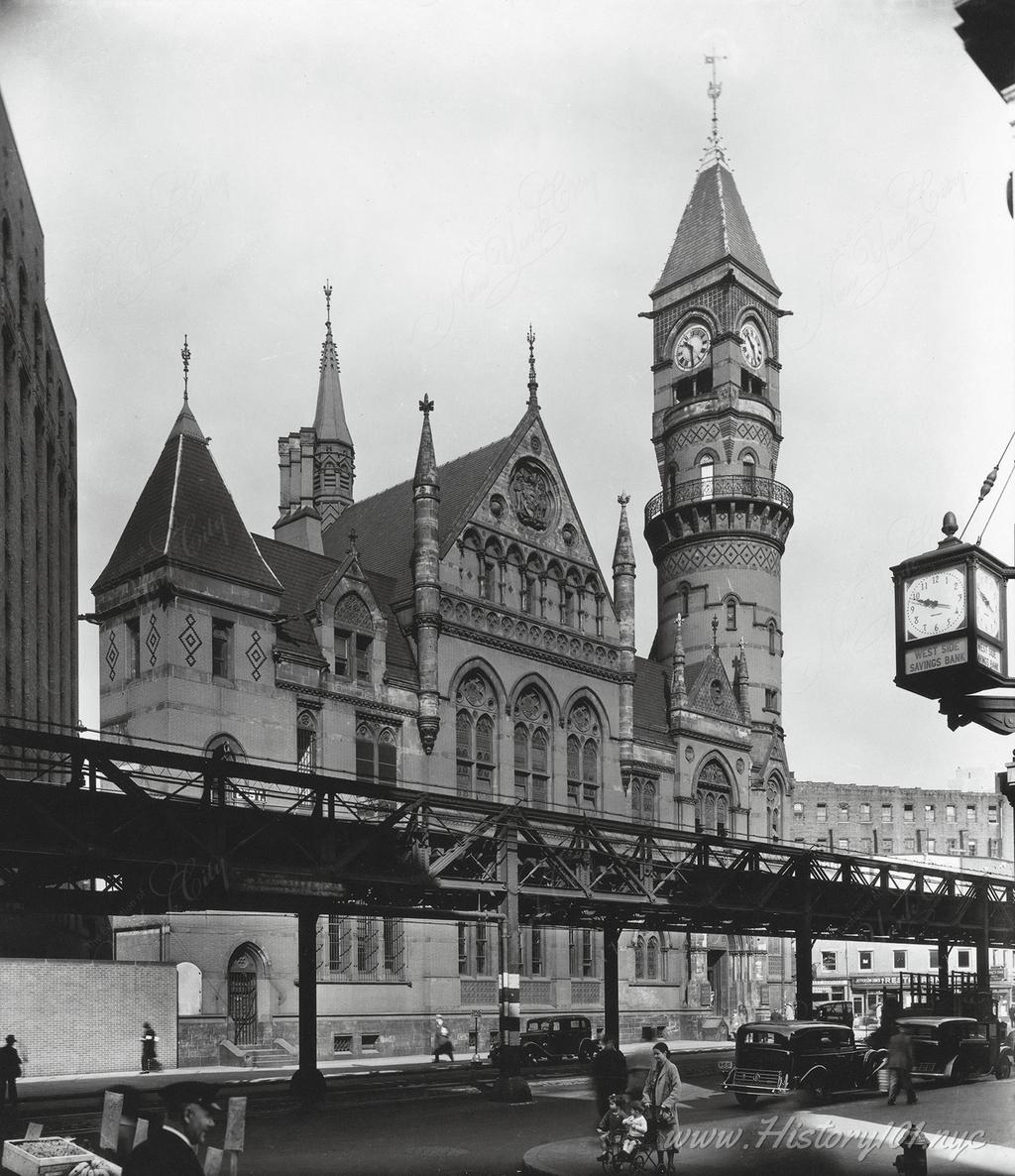
1935-1940 NYC: A Resurgence in Culture, Modernization & Municipal Infrastructure
The period from 1935 to 1940 in New York City was marked by significant transformations, reflecting a blend of enduring resilience and cultural evolution. Emerging from the depths of the Great Depression, the city experienced a resurgence in several areas, driven by New Deal initiatives and a vibrant cultural scene.
One of the most notable aspects of this era was the continuation of the New Deal, which brought substantial federal investment into urban infrastructure and public works. Projects like the LaGuardia Airport, opened in 1939, and the Triborough Bridge, completed in 1936, not only provided much-needed employment but also reshaped the city’s physical landscape. These developments were crucial in modernizing New York City and preparing it for the demands of the coming decades.
Culturally, the late 1930s in New York City saw an explosion of artistic expression. The Harlem Renaissance continued to influence music, literature, and art, solidifying the city’s status as a cultural hub. The advent of big-band jazz and swing, with iconic figures like Duke Ellington and Benny Goodman, brought a new energy to the city’s nightlife and entertainment scene.
Economically, the city began to recover from the Depression, with Wall Street regaining momentum. This period also saw the growth of industries like publishing and advertising, which would come to play significant roles in the city’s economy. New York’s media and entertainment industries, bolstered by the burgeoning film and theater sectors, contributed to its reputation as a center for innovation and creativity.
Socially, New York City continued to be a melting pot of diverse cultures and communities. The influx of immigrants and the internal migration of Americans seeking opportunities in the city added to its dynamic and varied social fabric. This diversity, while presenting challenges, also fueled the city’s unique character and vitality.
As the world edged closer to the Second World War, New York City stood as a testament to urban resilience and cultural richness, poised to face new challenges and continue its legacy as a global metropolis.
Timeline of New York City’s History 1935-1940
Discover surprising historical facts about The City That Never Sleeps—explore fun, educational insights into its history, population, iconic landmarks, and more, perfect for students, history enthusiasts, and anyone curious about NYC’s rich heritage.
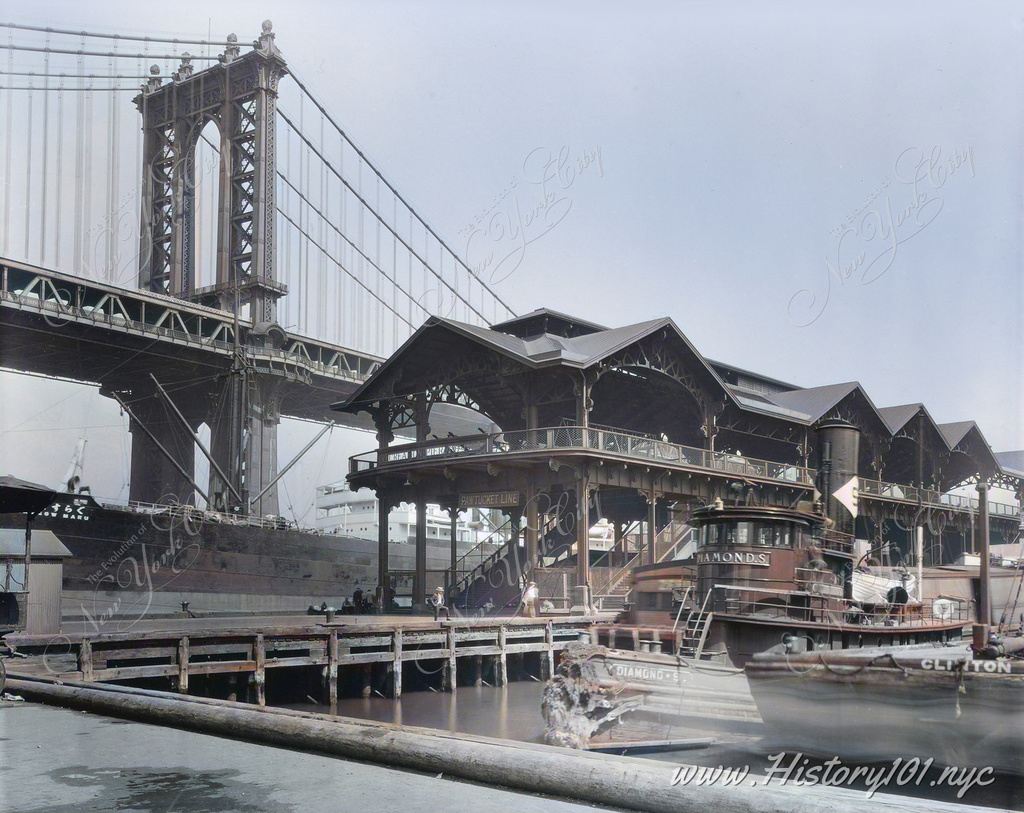
1935: Manhattan Bridge Recreational Area
In this captivating snapshot by Berenice Abbott from 1935, the dynamic scene unfolds against the backdrop of the Manhattan Bridge
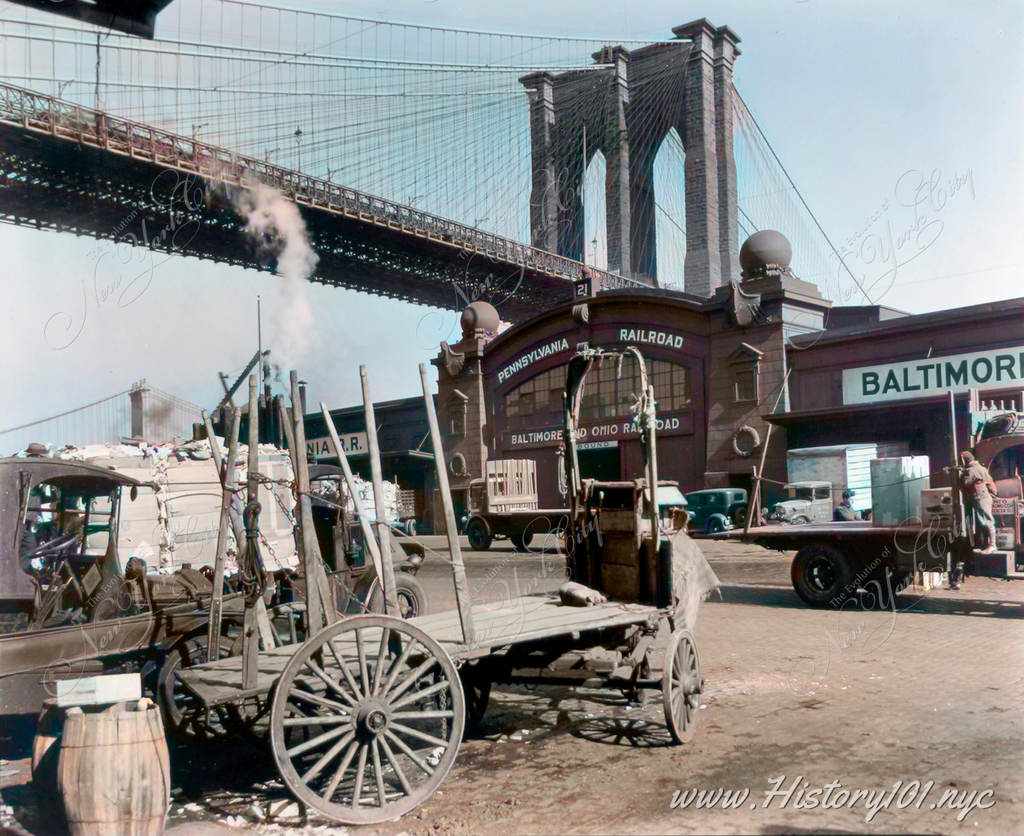
1937: Brooklyn Bridge, Pier 21
Photograph of trucks and wagons parked on Pier 21 at the Brooklyn Bridge on the Manhattan side.
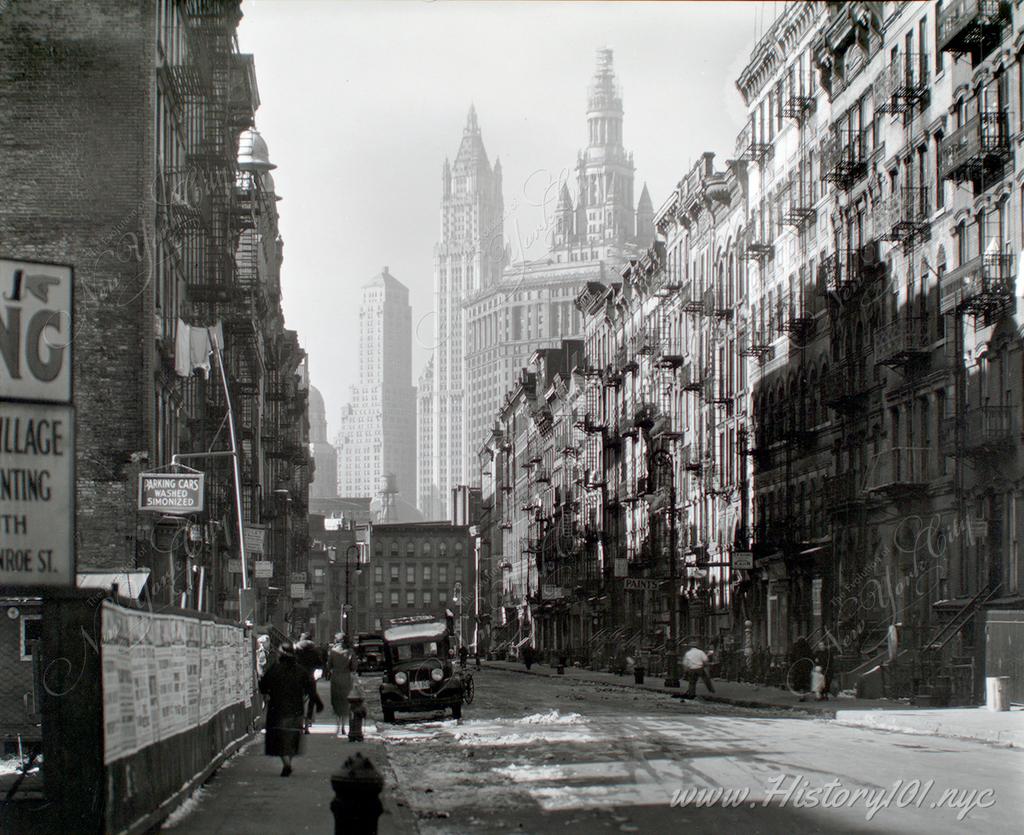
1935: Henry Street and the Downtown Skyline
A street level view of Henry Street and Manhattan's growing skyline. City Hall and the Woolworth Building are visible in the distance.
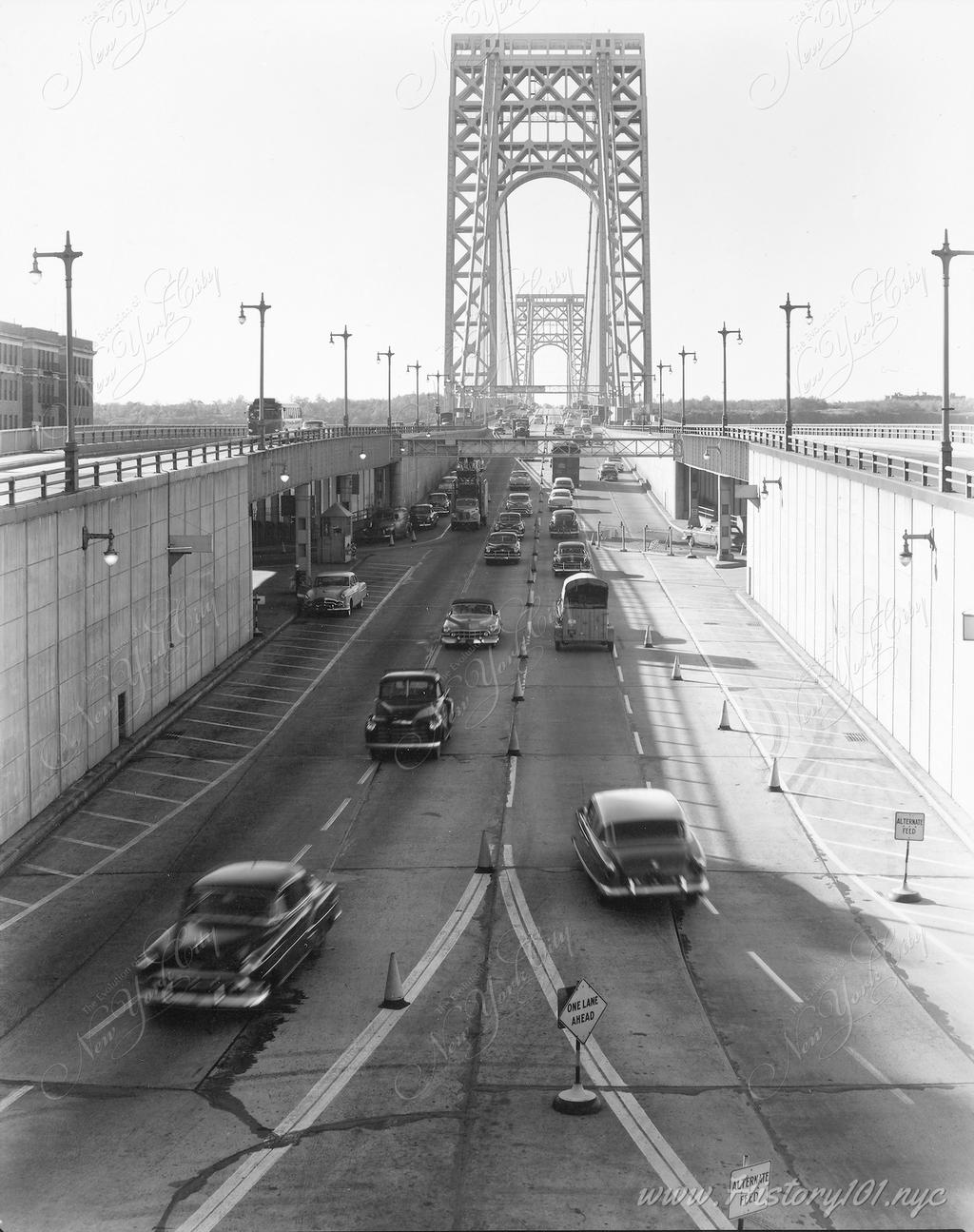
1937: The George Washington Bridge
Photograph shows inbound and outbound traffic at the Manhattan side entrance of the George Washington Bridge, which was built in 1927.
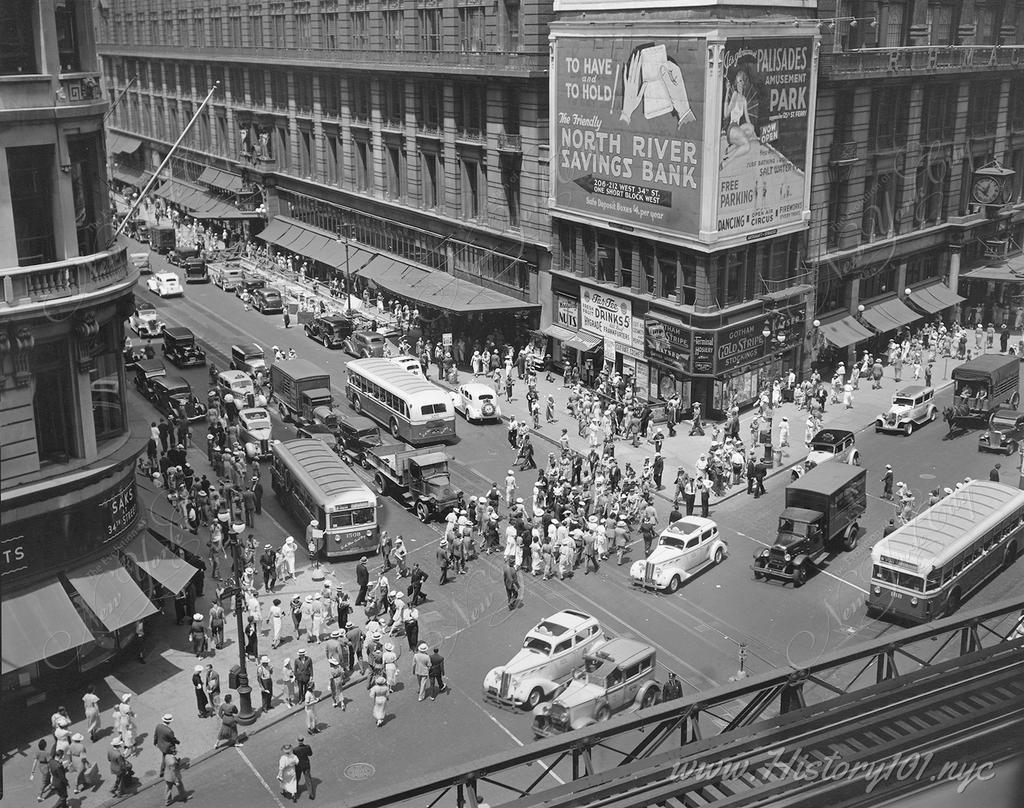
1936: Traffic at Herald Square
An overhead view of Herald Square the corner of 34th Street and Broadway showing cars, pedestrians and elevated railroad tracks in the foreground.
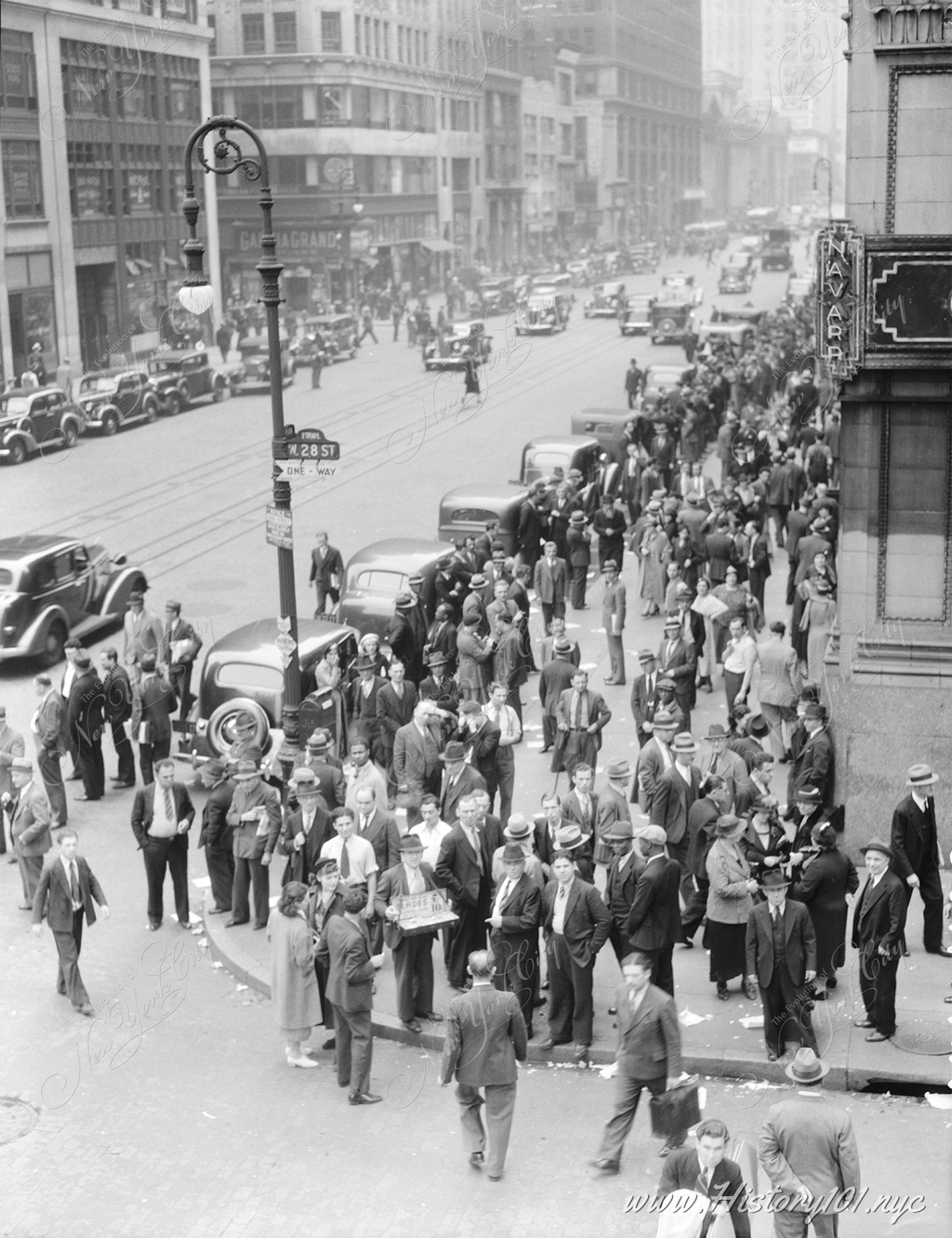
1936: Lunch Hour at 28th Street and 7th Avenue
Elevated view of garment workers leaving factories for noon hour at the intersection of 7th Avenue and West 28th Street, Manhattan.
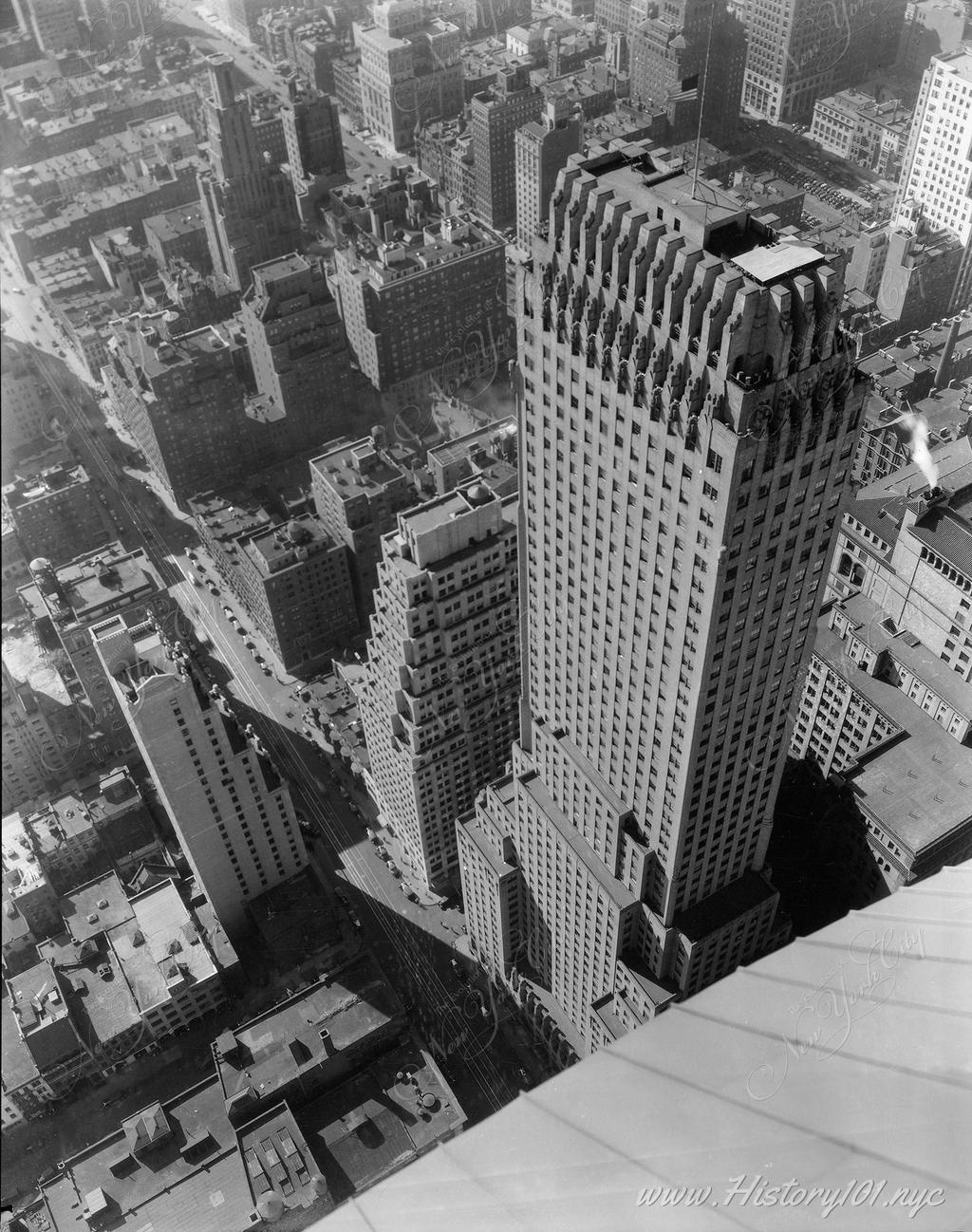
1935: The Chanin Building, Midtown Manhattan
Photograph of the Chanin Building and midtown Manhattan from a bird's eye perspective, taken from the Chrysler Building.
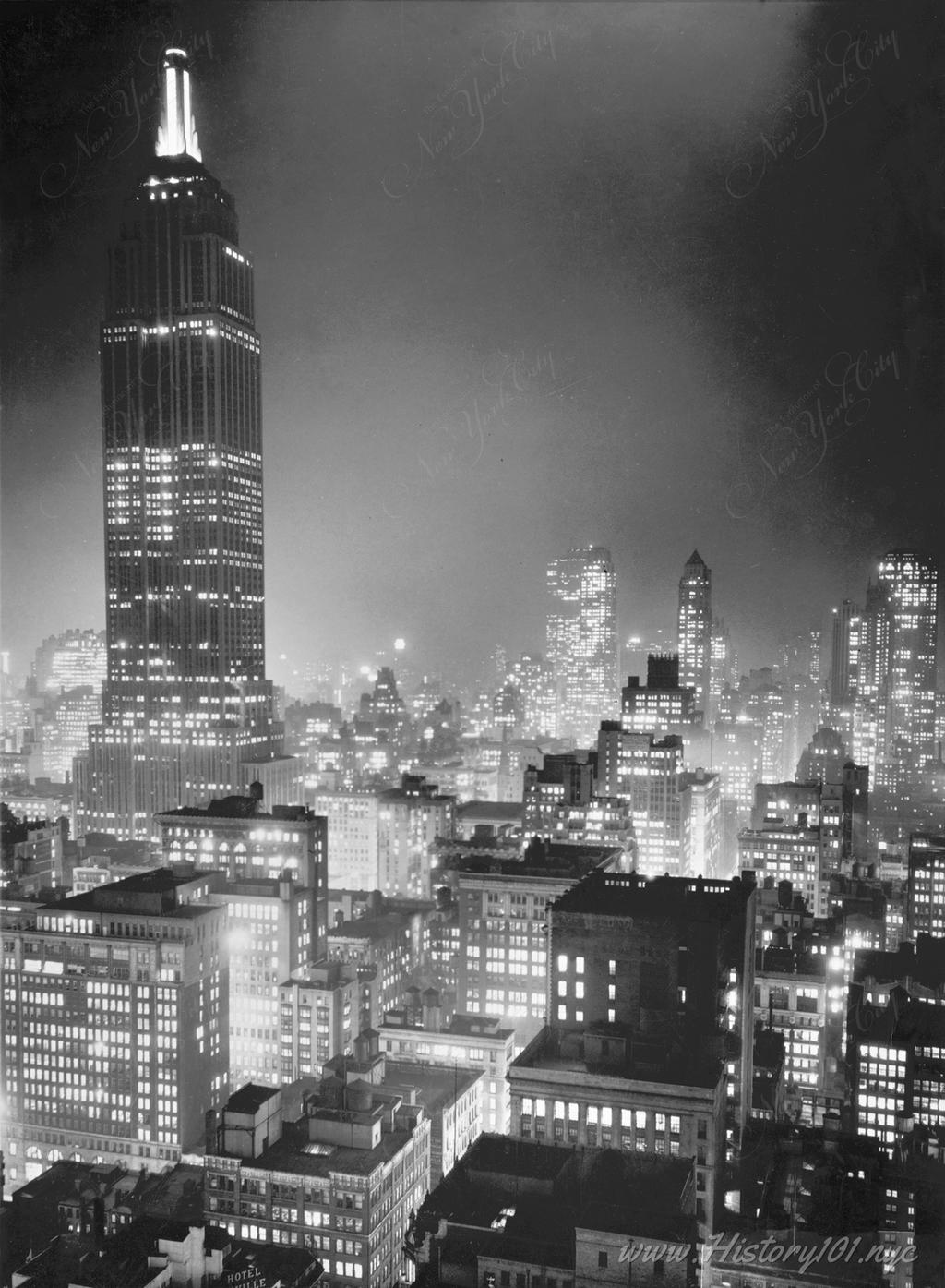
1937: Empire State Building at Night
Photograph of the Empire State Building and surrounding skyscrapers illuminated at night.
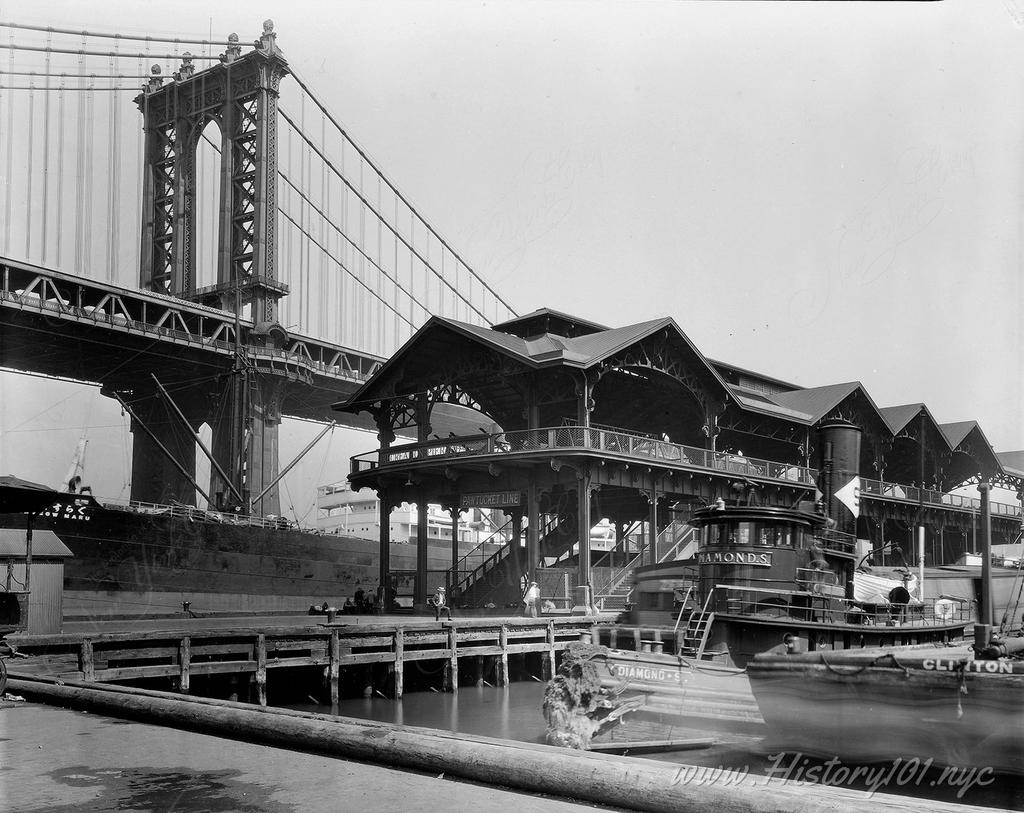
1935: Manhattan Bridge Recreation Area
Photograph of a Recreation Area with various boats docked in front with the Manhattan Bridge in the background.
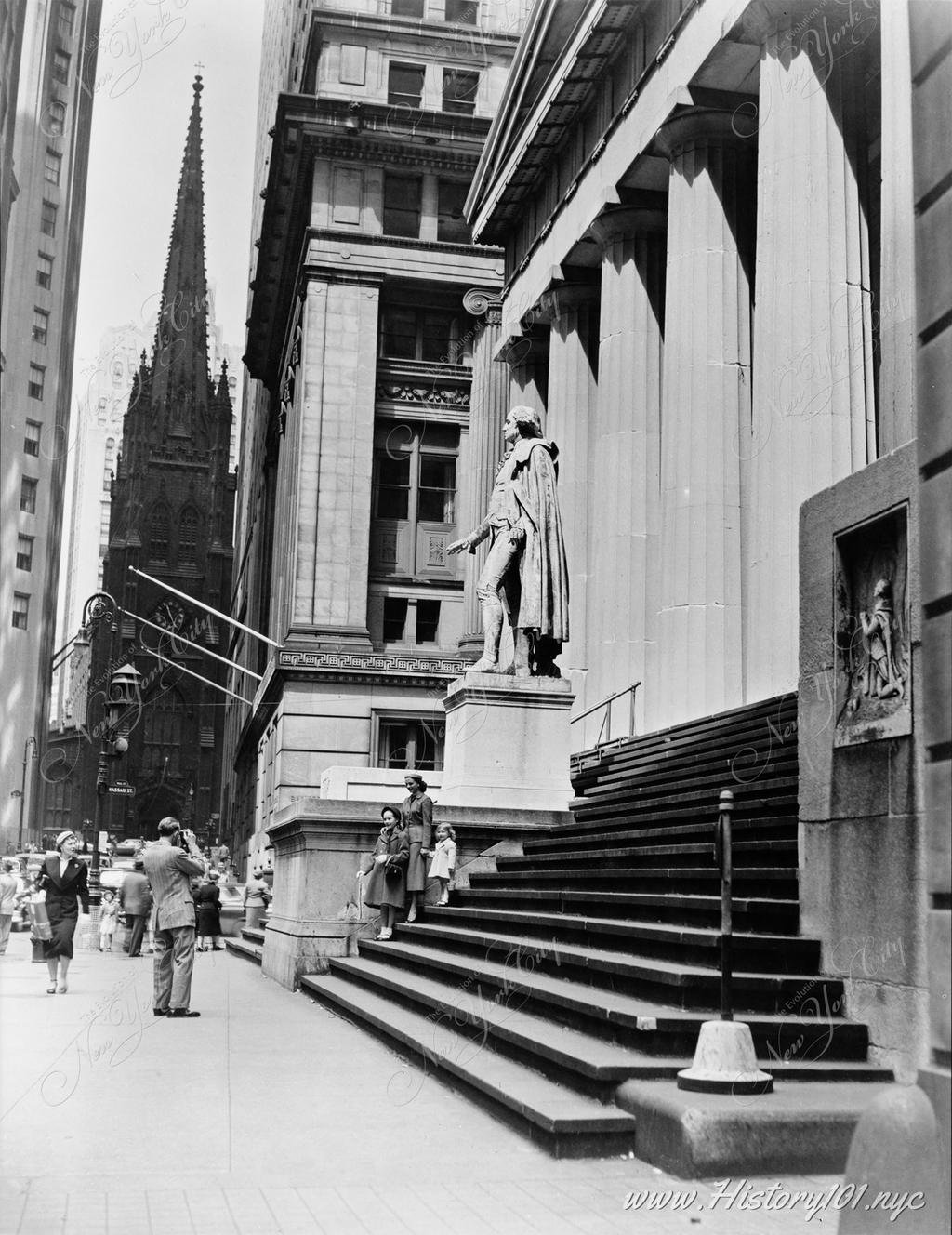
1937: Family Portrait at US Custom House
A woman poses with two small children in front of the side entrance of US Custom House in downtown Manhattan
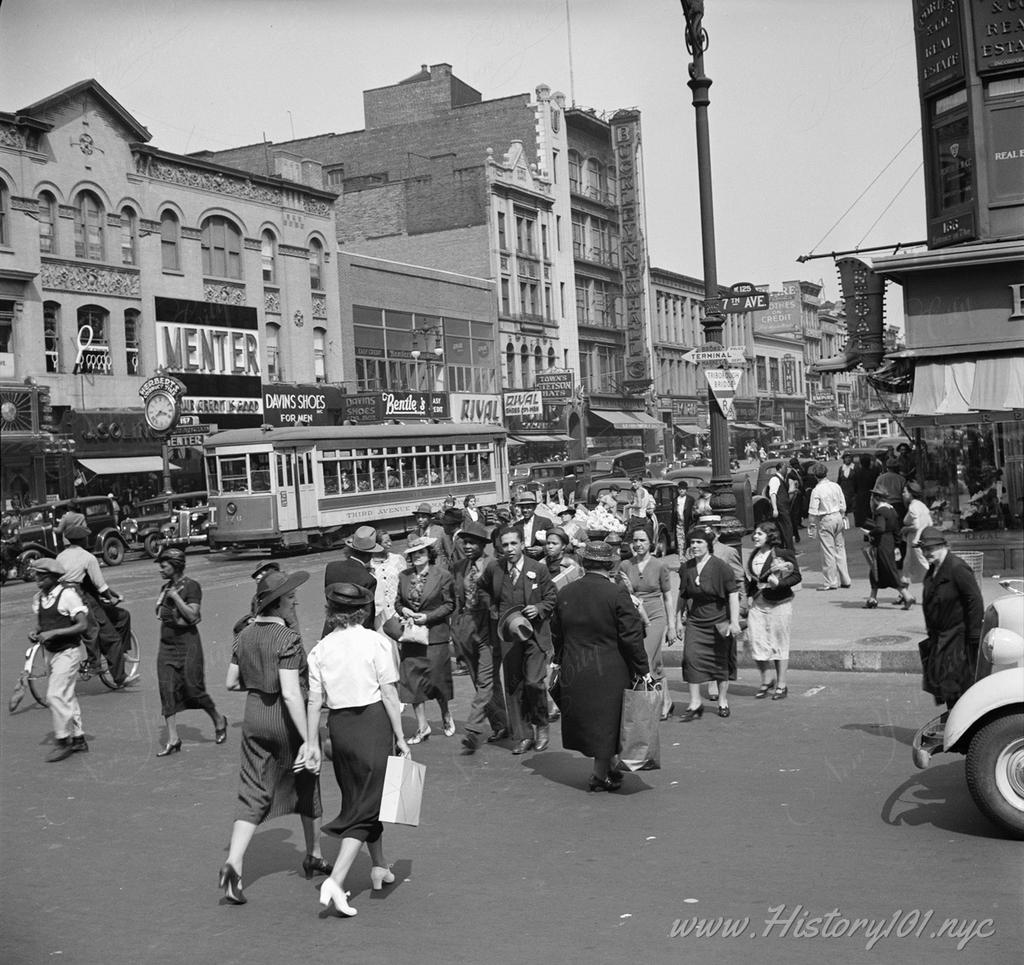
1938: Harlem-125th Street and 7th Avenue
Photograph of traffic and pedestrians on the corner of 125th Street and 7th Avenue in Harlem.
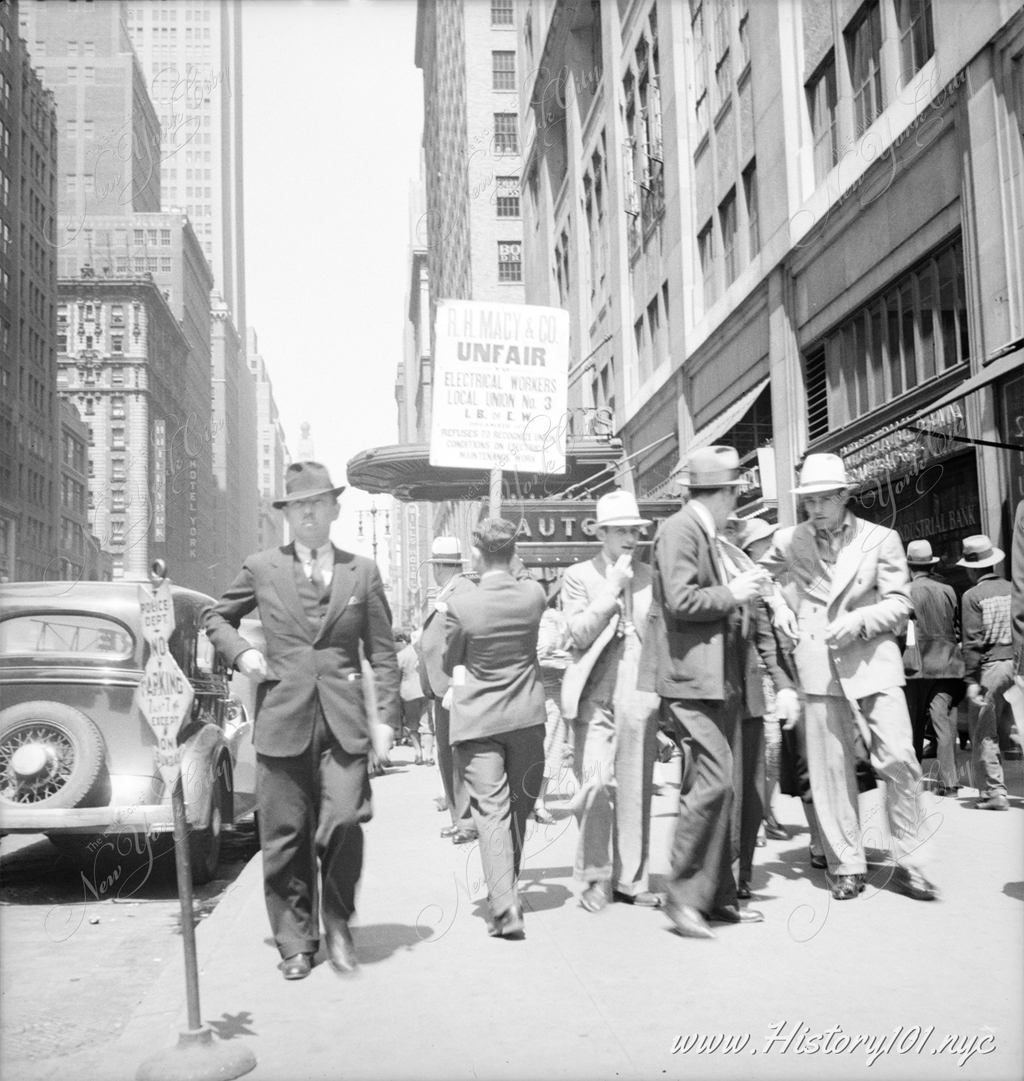
1936: Macys 7th Ave Entrance Looking North
Photograph of a busy street scene, looking north towards 35th Street from the 7th Avenue entrance of Macy's department store.
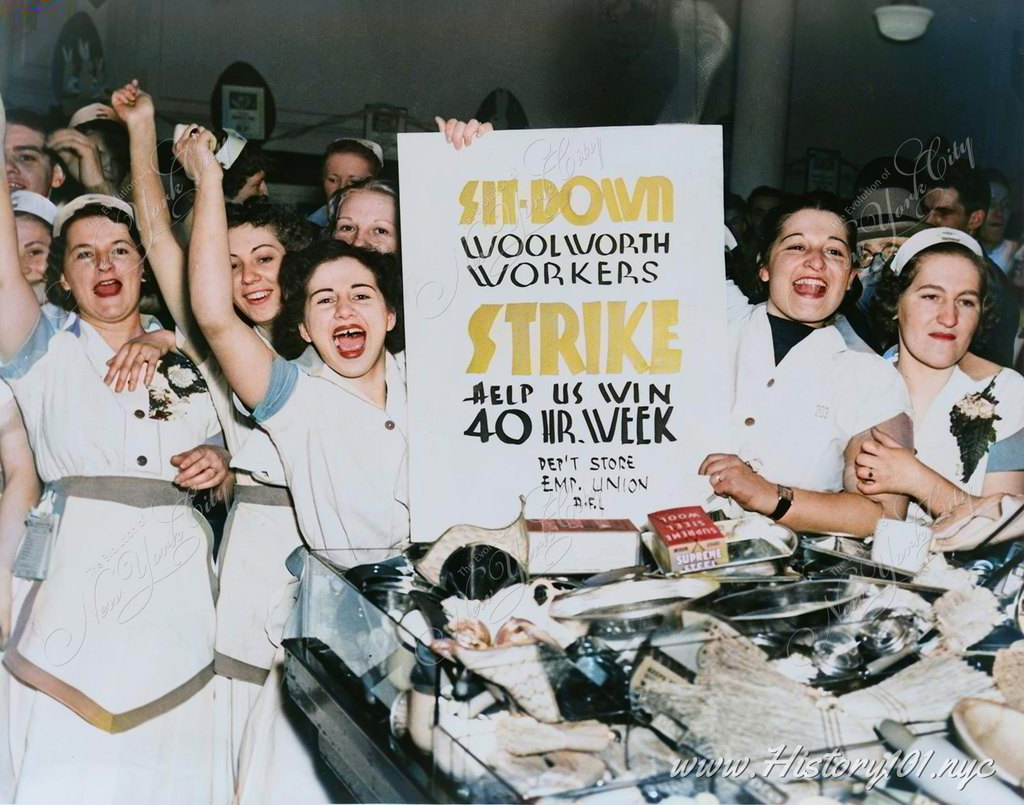
1937: Woman on Strike at Woolworth
The image depicts a significant moment in American labor history, likely from the late 1930s or early 1940s. Female employees of F.W. Woolworth Company, one of the largest retail chains of the era, are shown engaging in a labor strike.
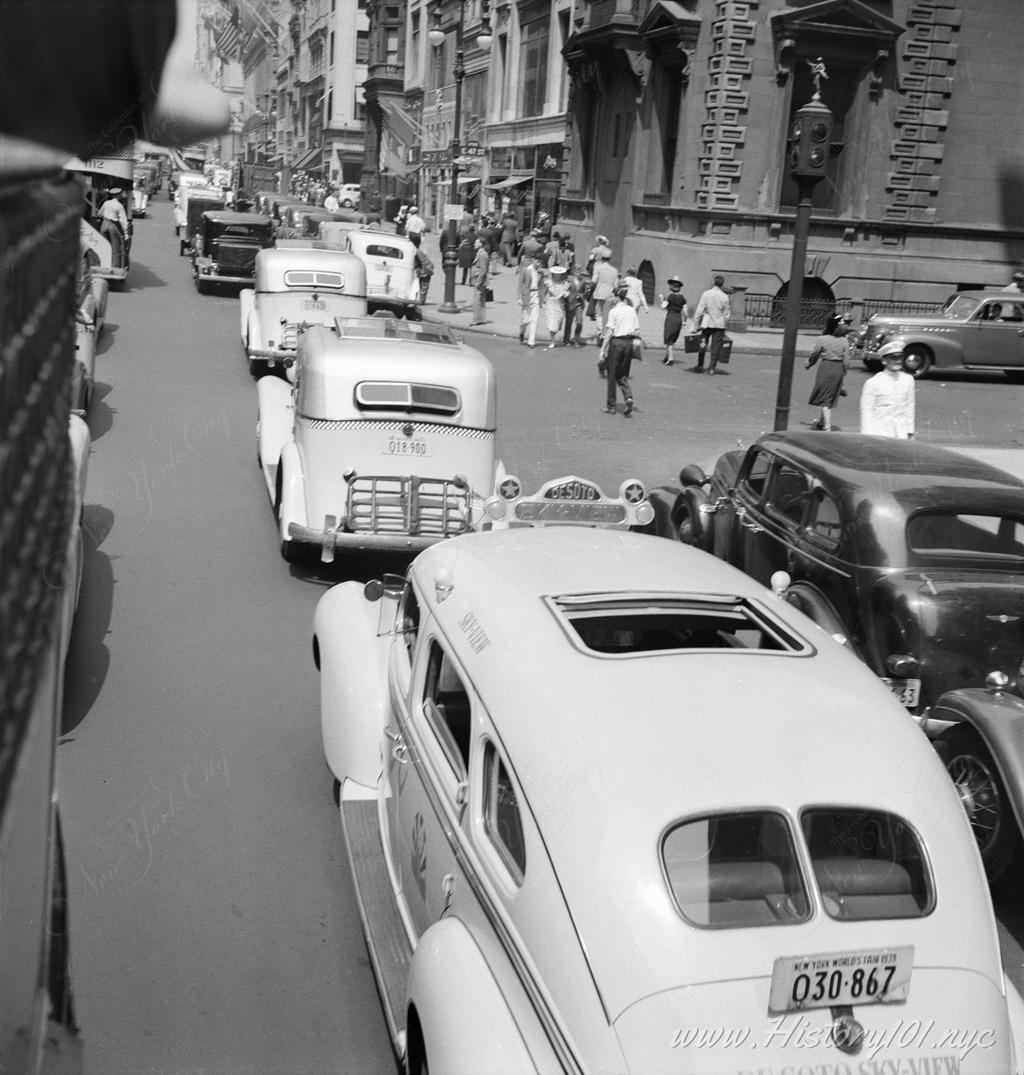
1939: Dorothea Lange’s Fifth Avenue Photo: A Glimpse of Midday Manhattan Traffic
Explore Dorothea Lange’s July 1939 photo of bustling Fifth Avenue traffic near 47th Street, revealing a vivid snapshot of Manhattan’s midday life
Timeline of New York City: 1935-1940
1935: Interpolated data from the 1930 and 1940 U.S. Census records provides a detailed estimate of the population across New York City's boroughs as of 1935, a year that marked significant changes within the metropolis. New York City’s total population was approximately 7,192,721, reflecting a period of growth driven by economic recovery and cultural shifts. Detailed estimates for the boroughs include the Bronx with a population of 1,329,985; Brooklyn, the most populous borough, with approximately 2,629,343 residents; Manhattan with 1,878,618; Queens with 1,188,382; and Staten Island, the smallest in terms of population, with 166,394 residents. These figures highlight the varying degrees of demographic change occurring throughout the city.
This era was crucial for New York City as it laid the foundations for its transformation into a global hub. The city was navigating through the complexities of urban development and demographic diversification, which would shape its socio-economic landscape for decades to come. The growth in population not only underscored the city’s appeal as a vibrant economic and cultural center but also its ability to integrate a burgeoning workforce essential for supporting its industrial and service sectors. The mid-1930s thus represent a pivotal moment in New York City’s history, setting the stage for its rise as an economic powerhouse and a melting pot of cultures and industries.
1935: George Gershwin's opera "Porgy and Bess" made its Broadway debut on October 10, at the Alvin Theatre in New York City. The opera is celebrated for its vibrant score and for pioneering the use of an all-Black cast in a major theatrical production, which was a significant and bold artistic choice during that era. This landmark event not only showcased Gershwin's talent as a composer but also marked an important moment in the history of American theatre by challenging racial norms and expanding the roles available to African American performers.
The narrative of "Porgy and Bess" explores the lives of Porgy, a disabled beggar, and Bess, who struggles within a turbulent relationship, set against the backdrop of an African American community in Charleston, South Carolina. The opera’s storyline and character development offer insights into the complexities of life and relationships within this community, making it a profound cultural reflection of its time. The premiere of "Porgy and Bess" brought critical attention to Gershwin and helped cement his legacy in American music and theatre, contributing a significant piece to the canon of 20th-century opera.
1935: The Frick Collection, a prominent art museum in New York City, officially opened its doors to the public on December 16. This event was met with great anticipation by the American press, highlighting its significance in the cultural landscape. The museum was established in the former residence of Henry Clay Frick, with architect John Russell Pope undertaking significant expansions to transform the original mansion into a six-story building suitable for public viewing. This renovation included the latest technological enhancements of the time and involved replacing the former porte-cochère with a new public entryway, marking a transition from private residence to public museum.
On its opening day, The Frick Collection showcased an exhibition featuring six paintings lent by Miss Helen Clay Frick from the family's private collection at Eagle Rock, illustrating the continuity between Henry Clay Frick’s personal art collecting legacy and the museum’s public mission. The museum's first director, Frederick Mortimer Clapp, was honored with a selection of architectural drawings by Angelo Magnanti, emphasizing the institution's commitment to both the arts and its architectural heritage. The collections housed within The Frick Collection include masterpieces by renowned artists such as Bellini, Fragonard, Gainsborough, Goya, and Rembrandt, among others, making it a pivotal institution for art enthusiasts. Additionally, the museum maintains specific visitor restrictions, only allowing children aged 10 and above, with those between 10 and 15 requiring adult accompaniment, ensuring a contemplative environment for its patrons.
1935: On December 27, the Federal Art Project (FAP) Gallery was inaugurated at 225 West 57th Street in New York City, marking a significant milestone in the history of American art during the Great Depression. This event was part of the Works Progress Administration (WPA), a critical element of President Franklin D. Roosevelt’s New Deal aimed at recovery from the economic downturn. The FAP was instrumental in providing employment to artists during a time of widespread economic hardship, and the opening exhibition, titled "Murals for Public Buildings," showcased the work of 27 artists. This exhibition included contributions from notable artists such as Arshile Gorky and Wyatt Davis, who collaborated on a piece for Floyd Bennett Field, highlighting the project’s focus on integrating art into public spaces.
The Federal Art Project not only supported artists financially but also played a crucial role in enriching the American cultural landscape by producing nearly 200,000 artworks before the program concluded in June 1943. It employed over 5,000 artists, including future luminaries like Jackson Pollock, Willem de Kooning, Mark Rothko, Ben Shahn, and Adolph Gottlieb. By fostering these talents, the FAP helped democratize the process of art-making, making it more accessible and affirming the value of art as work. This legacy continues to influence the art world, underscoring the importance of governmental support for the arts and its impact on society. Through exhibitions like the one at the FAP Gallery, the program not only provided relief to struggling artists but also cultivated a new era of American art that would shape artistic expressions for generations.
1935: New York City Water Tunnel No. 2 stands as a monumental achievement in the city's infrastructure history. This tunnel, which was the longest large-diameter water tunnel in the world at the time of its completion, extends from the Hillview Reservoir in Yonkers, passes beneath the central Bronx and the East River, and continues through western Queens to Brooklyn. In Brooklyn, it connects with Tunnel 1 and extends further to link with the Richmond Tunnel, which serves Staten Island. This critical piece of infrastructure was designed to enhance the city's capacity to distribute water efficiently across its boroughs, ensuring a reliable supply to meet the growing demands of its population.
The construction of New York City Water Tunnel No. 2 not only marked a significant technological feat but also reinforced the city's commitment to improving public utilities. The tunnel's strategic routing under major water bodies and through several boroughs exemplifies the complex engineering and planning required to execute such a project successfully. By connecting with other major water tunnels, it helped create an integrated system that could support the city’s expansion and the needs of its residents. The completion of this tunnel in 1935 provided a foundation for future expansions and upgrades to New York City's water supply system, which continues to benefit from the foresight and investments of the past.
1936: New York City's water supply system is an engineering marvel, drawing high-quality water from reservoirs located within the Hudson Valley and the Catskill Mountains. This pristine water is collected in large, protected reservoirs across three separate systems, ensuring its purity right from the source. The water is then transported to the city via large aqueducts, which play a crucial role in delivering this vital resource to the city’s residents. From there, it flows through massive underground water tunnels that distribute it throughout the five boroughs, illustrating the complexity and efficiency of New York City’s water infrastructure.
City Water Tunnel No. 2, a key component of this system, was activated in 1936 and serves the boroughs of Queens and Brooklyn. This tunnel complements the earlier City Water Tunnel No. 1, which went into service in 1917 and primarily serves the Bronx and Manhattan. These tunnels are part of a broader network that includes the Richmond Tunnel, introduced in 1970 to supply Staten Island, and its backup, the Staten Island Siphon, completed in 2016. This expansive network ensures that clean and safe drinking water reliably reaches all corners of the city, showcasing New York City's commitment to maintaining a robust and sustainable water supply system.
1936: New York City Mayor Fiorello H. LaGuardia founded the High School of Music & Art (M&A), realizing his vision to create a specialized public school for the city's most talented students. Mayor LaGuardia envisioned a unique educational environment where gifted students could nurture their artistic or musical talents while also receiving a comprehensive academic education. Originally located at 135th Street, the school quickly became a nurturing ground for young talents, offering specialized departments in Art, Instrumental Music, and Vocal Music. This initiative was part of Mayor LaGuardia's broader efforts to enhance educational opportunities in New York City and provide platforms for exceptional talents to flourish.
Originally established at 135th Street, the school quickly became a nurturing ground for young talents, offering specialized departments in Art, Instrumental Music, and Vocal Music. This initiative was part of Mayor LaGuardia's broader efforts to enhance educational opportunities in New York City and provide platforms for exceptional talents to flourish. Over time, the institution evolved and relocated to 100 Amsterdam Avenue, New York, NY 10023, where it is now known as LaGuardia High School. This new location continues to uphold Mayor LaGuardia’s vision, fostering the artistic and musical talents of New York City's gifted students in a dynamic and inspiring environment.
1936: Edsel Ford, the son of Henry Ford who founded the Ford Motor Company, established the Ford Foundation with an initial gift of $25,000. The foundation was initially operated in Michigan, predominantly under the leadership of Ford family members. The founding charter of the Ford Foundation declared its commitment to supporting "scientific, educational and charitable purposes, all for the public welfare," which guided its early philanthropic efforts. Through this mandate, the foundation extended grants to a diverse array of organizations, establishing its role in promoting public welfare through varied philanthropic contributions.
The Ford Foundation underwent a significant transformation after the deaths of Edsel Ford in 1943 and Henry Ford in 1947. Their bequests dramatically increased the foundation's resources, turning it into the world's largest philanthropy at the time. Under the leadership of Henry Ford II, Edsel’s eldest son, the foundation sought to strategically utilize its enlarged endowment. To achieve this, Henry Ford II and the board of trustees initiated a comprehensive review led by a blue-ribbon panel, headed by H. Rowan Gaither. This panel was tasked with determining the most effective ways for the foundation to allocate its resources, setting the stage for its future global impact in various philanthropic domains.
1936: New York City saw an expansive growth in its recreational infrastructure, a testament to the fruitful application of New Deal initiatives and the organizational prowess of Robert Moses, the city’s influential Parks Commissioner at the time. This era marked the completion of a significant number of public amenities, including hundreds of new playgrounds that provided safe and structured play areas for the city’s children. The development also included the addition of three zoos and ten golf courses, enhancing both the leisure and sporting landscapes of the city. Additionally, 53 recreational buildings were constructed, further bolstering the community facilities available to New Yorkers.
The summer was particularly notable for the inauguration of 11 massive outdoor swimming pools, each designed to accommodate around 5,000 people. These pools were distributed across various neighborhoods, providing a crucial public service during the sweltering heat of that year. The opening of Orchard Beach in the Bronx and Jacob Riis Beach in Queens also occurred during this period, offering expansive new waterfront recreational spaces to the public. These projects were not only significant for their immediate utility but also for their lasting impact on New York City’s social and urban fabric, fostering a greater sense of community and accessibility to quality public spaces.
1936: The Triborough Bridge, an iconic piece of New York City's infrastructure, officially opened to traffic on July 11. This monumental project, which took seven years to complete at a cost of $60 million, effectively connected the boroughs of Manhattan, Queens, and the Bronx. The bridge's design included a 2,780-foot main span from Queens to Ward's Island, a 700-foot lift bridge from Randalls Island to 125th Street in Manhattan, and a 1,217-foot truss bridge linking Randalls Island to the Bronx. Additionally, the project encompassed 14 miles of approach highways and parkways, along with parks and recreational facilities, enhancing the bridge's utility and accessibility.
The bridge's grand opening was celebrated with a dedication ceremony that saw notable attendees such as President Franklin D. Roosevelt, Mayor Fiorello LaGuardia, and urban planner Robert Moses. The creation of the Triborough Bridge Authority by the New York State Legislature in 1933 was pivotal in resuming construction during the Great Depression after the city had initially abandoned the project. This authority later evolved into the Triborough Bridge and Tunnel Authority (TBTA), which today operates a significant network of seven bridges and two tunnels across the city. In recognition of its engineering significance and historical value, the Triborough Bridge Project was designated a National Historic Civil Engineering Landmark by the American Society of Civil Engineers in 1986, cementing its legacy as a critical component of New York City's transportation infrastructure.
1936: A significant advancement in urban planning and recreational infrastructure was realized in New York City with the opening of the Grand Central, Interborough, and Laurelton Parkways. These thoroughfares were designed as modern highways enveloped in strips of parkland, defining a new category of road known as a parkway. This design was intended to enhance the scenic driving experience while also restricting direct access to the roadway, thereby promoting a smoother traffic flow amidst natural beauty. The integration of parkways within the city's park system highlighted a modern approach to urban development, blending functionality with aesthetic enjoyment.
The development and opening of these parkways are credited to the visionary efforts of Robert Moses, a pivotal figure in New York City's urban development. Moses' influence extended deeply into the transformation of the city's landscape, particularly through the creation of roads that also served as public parks. These parkways not only facilitated efficient vehicular movement but also significantly enriched the city's park system, offering residents new recreational spaces and routes for leisurely drives. This era of parkway construction under Moses' guidance marked a transformative period in urban planning, emphasizing the dual objectives of enhancing transportation networks and public park access in New York City.
1936: Don Prudencio Unanue and his wife Carolina, both Spanish immigrants, founded Goya Foods. The business began in a modest storefront on Duane Street in Lower Manhattan, aiming to serve the local Hispanic community by distributing authentic Spanish products. The initial product lineup featured essentials such as olives, olive oil, and sardines, catering to the tastes and culinary traditions of the area's Latino families. This focus on providing high-quality, traditional foods quickly established Goya as a trusted name among consumers, setting the foundation for future growth.
Over the decades, Goya Foods has grown to become the largest Hispanic-owned food company in the United States. As of today, Goya manufactures, packages, and distributes over 2,500 products from various Spanish-speaking regions including Spain, the Caribbean, Mexico, Central, and South America. The company's products are widely available across major national club stores such as Costco, Sam's Club, and BJ's Wholesale, ensuring that a diverse range of Goya's offerings reaches a broad audience. The founders' commitment to quality is encapsulated in the company's enduring motto, "If it's Goya, it has to be good," reflecting their ongoing dedication to excellence and authenticity in their product offerings.
1936: The Henry Hudson Bridge, an architectural marvel named after the famed explorer Henry Hudson, officially opened on December 12. This significant structure, which connected the initial sections of the Henry Hudson Parkway, was overseen by the Parks Commissioner Robert Moses. At the time of its inauguration, the bridge was celebrated as the world's longest plate girder arch and fixed arch bridge. Constructed by the American Bridge Company for the Henry Hudson Parkway Authority, the project amounted to a cost of $4.949 million. The bridge was initially built as a single-deck structure, with its design allowing for an upper level to be added later to accommodate increasing traffic demands.
The Bridge, aptly named after the explorer Henry Hudson whose ship, the Half Moon, anchored near the site in 1609, stands as a symbol of historical and architectural significance. This name not only commemorates Hudson's pivotal exploration of the area but also enhances the cultural heritage of the bridge, connecting it deeply with the city's early history. The completion of the bridge's upper level on May 7, 1938, significantly expanded its capacity, underlining its critical role in New York City’s transportation infrastructure. Strategically designed and located, the bridge improved connectivity between Manhattan and the Bronx, thereby facilitating smoother and more efficient travel across the Hudson River.
1936: The World Series, marking the 33rd edition of Major League Baseball's championship series, featured a historic matchup between the New York Yankees and the New York Giants, with the Yankees emerging victorious in six games to claim their fifth championship title. This series was particularly notable as it was the Yankees' first World Series appearance without Babe Ruth, who had been released after the 1934 season. The series also introduced a new Yankee star, Joe DiMaggio, who made a significant impact in his rookie season. DiMaggio, along with veterans like Lou Gehrig and Bill Dickey, propelled the Yankees to a dominant season, and their success carried over into the postseason. The series began on October 7, with the Yankees playing without Ruth but showcasing their new talent and depth.
Throughout the series, the Yankees demonstrated their offensive prowess and pitching depth. Pitchers Red Ruffing and Monte Pearson were key contributors, with Ruffing winning the opening game of the series against Giants' ace Carl Hubbell. The Yankees' lineup was formidable, with Tony Lazzeri hitting the second grand slam in World Series history during the series. Despite losing the first game, the Yankees won four of the next five games, including a decisive 18-4 victory in Game 2 and wrapping up the series with a 13-5 win in Game 6 on October 10. This victory not only secured the Yankees' fifth World Series title but also marked the beginning of a new era in their storied history, one that would see them dominate baseball for the next decade.
1937: Construction of the Delaware River water supply system, a crucial initiative for New York City's water needs, began in March. This significant undertaking was first enabled by a Supreme Court ruling in May 1931, which resolved a long-standing dispute between New York and New Jersey over the use of the river's tributaries, favoring New York. The system, designed to enhance the city's water resources, includes the Delaware Aqueduct—celebrated as the world's longest tunnel upon its completion and four major reservoirs: Rondout, Neversink, Pepacton, and Cannonsville. The first construction contracts were awarded on January 22, setting in motion a project that would eventually greatly bolster the city's water infrastructure.
The Delaware Aqueduct was a monumental feat of engineering, completed in 1944 and becoming the longest continuous tunnel in the world. Following the aqueduct's completion, the focus shifted to the reservoirs, with Rondout Reservoir coming online in 1950, Neversink in 1954, Pepacton in 1955, and finally, Cannonsville Reservoir in 1964. Each stage of the system's development was meticulously planned and executed, ensuring a reliable supply of water to meet the growing demands of New York City. The entire Delaware water supply system was operational in stages, with each component enhancing the robustness and reliability of the city's water infrastructure, proving essential for supporting its burgeoning population and sprawling urban landscape.
1937: The Carnegie Deli, a staple of New York City’s culinary landscape, first opened its doors. Located at 854 7th Avenue, nestled between 54th and 55th Streets in Midtown Manhattan, this Jewish delicatessen quickly became renowned for its hefty servings of pastrami, corned beef, cheesecakes, and an array of both Jewish and non-Jewish foods. The deli’s proximity to Carnegie Hall not only influenced its name but also helped it attract a diverse crowd that included everyday New Yorkers and celebrities alike, all drawn in by its famous oversized sandwiches and its vibrant, albeit sometimes surly, dining atmosphere.
Despite its iconic status and popularity, Carnegie Deli faced several challenges over the years that eventually led to its closure. Moreover, the deli’s public profile was marred by a contentious divorce that reportedly involved the theft of its cherished pastrami and cheesecake recipes. Ultimately, the deli's owner, announced the closing of its landmark location, which officially ceased operations on December 31, 2016. While the main branch has closed, Carnegie Deli still maintains a presence at Madison Square Garden and continues its wholesale distribution service, preserving a piece of its legacy in New York City's culinary history.
1937: The Stage Deli, a notable New York City delicatessen, first opened its doors on Broadway and 48th Street. Founded by Max Asnas, a Russian-Jewish immigrant, the deli quickly became famous for its overstuffed sandwiches named after celebrities and Broadway-themed dishes, such as the "Mamma Mia!" sandwich. It attracted a glamorous clientele over the years, including Judy Garland, President Bill Clinton, and celebrities like Adam Sandler and Dolly Parton. Known for its tongue-in-cheek promotions and special events like the Matzoh Bowl, which celebrated the best matzoh ball soup, the Stage Deli carved out a unique niche in the competitive dining scene of New York.
Despite its popularity and iconic status, the Stage Deli closed its doors on November 29, 2012, after 75 years of operation. The closure was attributed to a combination of factors including increased rent, the rising cost of doing business in New York, and stiff competition from nearby establishments like the Carnegie Deli. The deli’s rivalry with Carnegie was well-known, marked by humorous disputes over which establishment offered the best pastrami. This rivalry even extended to promotional antics, with the Stage Deli claiming superiority because it used New York water for its pastrami, unlike its competitor. The Stage Deli's impact on New York’s culinary and cultural landscape remains a cherished memory for many, symbolizing an era of dining that celebrated personality, history, and good food.
1937: On April 28, New York City witnessed the debut of the first animated electric sign along Broadway, signaling a significant advancement in advertising technology. This groundbreaking sign was capable of displaying animated sequences through the coordinated blinking of its 2,000 light bulbs, creating cartoon-like scenes. The display, which featured a cavorting horse and ball-tossing cats among other images, offered a four-minute spectacle that captivated passersby. This innovation in sign technology, placed prominently in Times Square, marked the early stages of modern digital billboards and reflected a shift towards more dynamic and engaging advertising methods. The sign not only drew public attention but also set a precedent for the future of outdoor advertising, enhancing the visual landscape of one of the world's most bustling urban centers.
The mastermind behind this technological marvel was Douglas Leigh, a visionary advertising executive whose creative prowess left a lasting imprint on Times Square's nighttime skyline. Leigh's contributions to the visual and cultural landscape of Times Square are unparalleled, especially with his iconic Camel cigarette sign that famously emitted smoke rings over New York's bustling streets in the 1940s. This innovative sign not only entertained onlookers but also highlighted Leigh’s ability to merge artistic creativity with technological innovation, enhancing the commercial appeal of outdoor advertising. His knack for creating engaging, dynamic advertisements helped redefine Times Square into a symbol of modern consumer culture, turning it into a global spectacle that drew millions of eyes.
1937: Over one hundred department store workers participated in a significant sit-down strike across five New York City chain department stores, notably those operated by the F. W. Grand stores of the X. L. Green Company. This movement was partly inspired by a successful similar action at Woolworth's in Detroit. The New York City strikers, largely consisting of employees from Grand department stores, demanded a forty-hour work week and higher hourly wages. During their twelve-day occupation, the workers organized their living quarters within the stores themselves, arranging for food, bedding, and other necessities while ensuring no merchandise was used or taken during the strike. They even hosted social events, including two engagement parties and a marriage ceremony, all within the store premises.
The strike culminated in a meeting at the New Yorker Hotel, where representatives of the Department Store Employees Union and company officials reached a settlement. While not all demands were met, the strikers achieved partial success with the acknowledgment of their union, the implementation of higher wages, and the negotiation of a forty-eight-hour work week. This event was marked by community support and minor confrontations, including the arrest of supporting picketers. The strike, which extended over Easter week, also saw workers organizing their own religious services, adapting to their prolonged stay in the stores. This labor action not only underscored the growing solidarity among retail workers but also highlighted their commitment to improving labor conditions in the early twentieth century.
1937: The 34th edition of Major League Baseball's World Series featured a rematch between the New York Yankees and the New York Giants. The Yankees triumphed in five games, securing their second consecutive championship and their sixth in the fifteen-year span from 1923, 1927, 1928, 1932, and 1936. By winning this Series, the Yankees gained a lead in head-to-head Series victories over the Giants, offsetting losses to them in 1921 and 1922. This Series was notable for its lack of fielding errors by the Yankees, the first occurrence in World Series history where a team played error-free throughout the series.
The Yankees handled 179 total chances (132 putouts and 47 assists) without a mistake. The fourth game of the series was also significant as it featured the final World Series innings pitched by Giants' Hall of Famer Carl Hubbell. During the ninth inning of that game, Hubbell allowed a home run to Yankees' Hall of Famer Lou Gehrig, which was Gehrig's final home run in World Series play. This series not only reinforced the Yankees' dominance in the baseball world but also underscored their transition to a new era post-Babe Ruth, with Joe DiMaggio now one of their leading players.
1937: On December 22, the Lincoln Tunnel, an engineering marvel designed by civil engineer Ole Singstad, opened to traffic, creating a crucial link between Weehawken, New Jersey, and Midtown Manhattan. The project, originally proposed in the 1920s as the "Midtown Hudson Tunnel," commenced construction in March 1934. The completion of the first tube allowed for the easing of congestion on New York City's bridges and ferries, marking a significant improvement in the city's transportation infrastructure. Its construction cost was just over $75 million, with the initial toll set at 50 cents per passenger automobile. The opening ceremonies were marked by grand festivities, including artillery salvos, shrieking whistles of harbor craft, dipping airplanes, and exploding aerial bombs.
The initial design of the Lincoln Tunnel called for two tubes, though the onset of the second tube's construction was temporarily halted in 1938, resuming only in 1941 due to various challenges. Eventually, two additional tubes were added in 1945 and 1957, respectively, making the Lincoln Tunnel the world's first triple-tubed vehicular tunnel. This expansion further alleviated traffic flow issues and enhanced the connectivity between New Jersey and Manhattan. The Lincoln Tunnel has since stood as a testament to the innovative spirit of its era, significantly contributing to the ease of commuting and fostering economic growth in the region.
1938: The Corporation Counsel of New York City enacted a significant administrative change, transferring jurisdiction over key recreational areas to the Parks Department. This shift affected the management of beaches and boardwalks at notable locations such as Coney Island in Brooklyn, Rockaway in Queens, and South Beach on Staten Island. Under the leadership of Parks Commissioner Robert Moses, this transition marked a pivotal moment in the city's approach to public space management. Moses initiated extensive improvements, including the expansion of beach and swimming areas, the enhancement of automotive access, and the systematic reduction of amusement attractions in these areas. His efforts aimed to make the beaches more accessible and appealing to the public, aligning with his vision of transforming New York City’s recreational facilities into more wholesome and family-friendly destinations.
Following this administrative adjustment, Moses embarked on an ambitious plan to revitalize and expand the city’s beachfronts. His approach was holistic, involving the demolition of outdated and deteriorating amusements such as music halls and carousels. These were replaced with modern amenities, including new boardwalks and extensive beachfront facilities, designed to accommodate the growing number of visitors. Notable projects included the construction of boardwalks at South and Midland Beaches in Staten Island, Coney Island, and at Rockaway and Jacob Riis Parks in Queens. Public infrastructure projects like the Belt Parkway and the Marine Parkway Bridge were also developed to improve access to these beachfronts, facilitating easier transport by both private vehicles and public buses. This period of intense development was supported by federal funding through programs like the Works Progress Administration, highlighting a successful partnership between city planning and federal resources to enhance urban public spaces.
1938: The Bronx High School of Science, one of the premier public high schools in the United States, was established, under the aegis of the New York City Department of Education. Situated initially at Creston Avenue and 184th Street in the Fordham section of the Bronx, the school opened with Dr. Morris Meister at its helm as the first principal. It was founded with a mission to nurture the scientific and mathematical talents of exceptionally gifted students. The school began with an enrollment of 150 ninth graders and 250 tenth graders, utilizing a Gothic structure that had previously served as part of Evander Childs High School. This building, erected in 1918, had been used by Walton High School and an annex of DeWitt Clinton High School before becoming the home of Bronx Science. The unique educational environment at Bronx Science was distinguished by its rigorous curriculum and an emphasis on advanced scientific training.
By 1946, the school had transitioned to a coeducational institution, reflecting its evolving approach to comprehensive educational excellence. The early years were marked by a vigorous campaign led by the Parents’ Association and Dr. Meister to secure a dedicated building for Bronx Science. This campaign culminated successfully with the construction of a new facility, which the school community moved into on March 3, 1959. This modern building was designed to support an advanced educational program with state-of-the-art laboratories and facilities, fulfilling the school’s commitment to fostering scientific inquiry and excellence. Dr. Meister, after two decades of leadership, resigned in 1958 to become the president of the newly established Bronx Community College, with Dr. Alexander Taffel succeeding him as principal.
1938: Chester Carlson, born in Seattle in 1906, invented the xerographic process, a groundbreaking method that significantly impacted the document reproduction industry. Despite a challenging upbringing and the hardships of the Great Depression, Carlson persevered, ultimately earning a physics degree from Caltech. His invention was initially called electrophotography and was based on the principles of photoconductivity. The idea came from his experience working in a patent office, where he recognized the need for a faster, more efficient method of copying documents. On October, in a humble setup in his Queens apartment, Carlson and his assistant, Otto Kornei, made the first xerographic copy. This event marked a pivotal moment in the development of what would later become a multibillion-dollar industry.
Carlson faced numerous rejections when he tried to commercialize his invention, with more than 20 companies turning him down. However, his determination paid off when, in 1944, the Battelle Memorial Institute recognized the potential of his invention and signed a royalty agreement to further develop the process. This partnership eventually led to Haloid (later Xerox) obtaining the rights to develop xerographic machines in 1947. The Xerox 914, the first office copier that could make copies on plain paper at the touch of a button, was released in 1959, transforming office work globally. Despite his profound impact on modern office technology, Carlson remained modest and philanthropic, donating over $100 million to charity before his death. His legacy continues to influence the copying and printing industries today.
1938: The Cloisters, a branch of The Metropolitan Museum of Art dedicated to medieval art, officially opened its doors on May 10, offering a new home for medieval art in America. The museum, situated in Fort Tryon Park overlooking the Hudson River in northern Manhattan, was designed not to replicate any one specific medieval structure, but to evoke the general atmosphere of the Middle Ages. This was achieved by integrating parts of five authentic European cloisters into a modern museum structure, creating an immersive environment that enhances the visitor’s experience of the medieval art on display.
The genesis of The Cloisters traces back to George Grey Barnard, an American sculptor and collector who initially opened a museum to house his collection of medieval art at the northern tip of Manhattan in the early 20th century. His efforts, combined with the generous financial support of John D. Rockefeller, Jr., who donated both the land for the current museum and parts of his own collection, facilitated the museum's development under the auspices of the Metropolitan Museum of Art. Designed by Charles Collens, the museum does not strictly mimic any historical architecture but instead creates an evocative space that reflects medieval styles and proportions, offering visitors a pathway through the Romanesque and Gothic periods within its meticulously arranged galleries.
1938: On May 29, New York City witnessed the Carnival of Swing at Randall's Island, an event celebrated as the first major outdoor jazz festival. The festival showcased an impressive lineup of 25 swing bands, including prominent figures such as Duke Ellington and Count Basie, along with notable performers like Ivie Anderson and Lester Young. The event, which lasted nearly six hours, attracted a massive audience of over 23,000 enthusiasts, highlighting the immense popularity and cultural significance of swing music during this era. This landmark festival not only featured stellar performances but also set a precedent for future outdoor music festivals in the United States.
Further enriching the historical significance of the Carnival of Swing, the National Jazz Museum in Harlem later acquired radio recordings of the festival, known as the Savory Collection. These recordings are invaluable as they capture the live performances of that day, preserving a pivotal moment in jazz history. Notably, the event was meticulously managed, with extensive security measures in place to ensure the safety of the performers and the orderly conduct of the vast crowd. The festival's success and its impact on the music scene are well-documented, marking a key milestone in the evolution of jazz festivals and public musical performances.
1938: On August 26, the fireboat Fire Fighter was launched, heralded as the world's most powerful diesel-electric fireboat at the time. Designed by the eminent naval architect William Francis Gibbs and constructed at United Shipyards on Staten Island, this vessel spanned 134 feet in length with a beam of 32 feet. After being formally christened, Fire Fighter underwent several months of training before being commissioned by the Fire Department of New York City (FDNY) on November 16. Throughout its illustrious service, the Fire Fighter battled more than 50 major fires, including the notable blazes on the SS Normandie in 1942 and the SS El Estero in 1943.
The Fire Fighter's career is marked by several heroic and significant operations, notably during the collision of the SS Sea Witch and the Esso Brussels on June 2, 1973, near the Verrazano-Narrows Bridge. Described as facing "a mountain of fire," the fireboat was first on the scene, playing a crucial role in rescuing 31 crew members from the inferno. For its gallantry, the vessel received the Gallant Ship Award, and its commanding officer, Lieutenant James F. McKenna, was awarded the Merchant Marine Meritorious Service Medal. Fire Fighter continued to serve the FDNY until 2010, participating in critical responses such as the September 11 attacks and the miraculous landing of U.S. Airways Flight 1549 in the Hudson River. Retired in 2010, it now serves as a museum ship in Greenport, New York, preserving its rich history for future generations.
1938: On September 15, New York City experienced a significant disruption when members of the Teamsters union, primarily from Local 807, initiated an unsanctioned strike. The strike, driven by demands for a 40-hour work week and higher hourly wages, effectively halted interstate trucking operations in and out of the city. The strikers employed tactics such as driving pickets throughout the downtown waterfront district, which successfully shut down work activities. Despite the deployment of special police details intended to break the picket lines early on the morning of the strike's commencement, these efforts proved unsuccessful.
The truckers' strike had lasting impacts beyond the immediate disruptions. It culminated in the Teamsters agreeing to a 44-hour work week, a concession that marked a significant victory for the union members. This event also catalyzed the expansion of Teamster organizing efforts into various other sectors, including warehouse workers, manufacturing workers, and public sector employees. The strike underscored the growing influence and organizational reach of the Teamsters, setting the stage for further union actions and negotiations that would shape the labor landscape of New York City and beyond in the decades that followed.
1938: On September 23, the Westinghouse Electric & Manufacturing Company buried the first "time capsule," intended not to be opened until the year 6939. This event took place at the New York World's Fair grounds, precisely at noon to coincide with the autumnal equinox. Positioned at the site of the Westinghouse exhibit, the capsule was filled with various 20th-century artifacts intended to represent contemporary American life. Among the eclectic mix of items included were seeds, microfilm and newsreels, everyday items like a woman's hat designed by Lilly Daché, a man's pipe, and a letter from Albert Einstein, all aimed at providing a snapshot of life in 1939 for future generations.
The significance of this time capsule extends beyond its contents; it was designed as a message to the future, a testament to the ingenuity and ambition of mid-20th-century American industry. Fabricated from a special non-corrosive metal to ensure its preservation, the capsule measures 90 inches in length and approximately nine inches in diameter. It was strategically placed fifty feet underground at Flushing Meadows-Corona Park, with its position marked and documented in thousands of record books distributed to libraries, museums, and institutions around the world. These records are meant to safeguard the knowledge of the capsule’s existence and its intended opening date in the seventh millennium, underscoring a profound faith in the durability of human memory and the persistence of human culture.
1938: The New York Yankees solidified their position as baseball's most dominant team on Oct. 9, when they completed a World Series sweep over the Chicago Cubs with an 8-3 victory at Yankee Stadium. Red Ruffing, a future Hall of Famer, pitched a complete game, scattering eight hits and earning his second win of the Series. This victory marked the Yankees' third consecutive World Series title, the first time in modern baseball history that a team had won three straight championships (three-peat). Bill Dickey, Joe DiMaggio, Lou Gehrig, and Joe Gordon, all future Hall of Famers, were key contributors in the Yankees' potent lineup.
During the 1938 season, the Yankees finished with a 99-53 record, comfortably winning the American League by nine and a half games over the Boston Red Sox. In contrast, the National League race was much tighter, with the Cubs overtaking the Pittsburgh Pirates on Sept. 28, thanks to Gabby Hartnett’s famous “Homer in the Gloamin’.” The Cubs finished at 89-63, but they were no match for the Yankees, who outscored Chicago 22-9 over four games. The Yankees would go on to win the World Series again in 1939, extending their streak to four consecutive titles.
1938: On December 11, the New York Giants faced the Green Bay Packers in the sixth NFL Championship Game, held at the Polo Grounds in New York City. This match attracted a record crowd of 48,120 spectators, setting a new attendance record for an NFL title game. The Giants, champions of the Eastern Division with an 8–2–1 record, clashed with the Western Division champion Packers, who posted an 8–3–0 record for the season. Earlier in the season, on November 20, the Giants had defeated the Packers 15–3 in a regular-season game at the same venue. However, the Packers were without Hall of Fame end Don Hutson for that game, making the championship match-up less predictable despite the Giants' earlier victory.
The game itself was marked by strategic plays and a memorable mishap involving Packers' head coach Curly Lambeau. Jim Lee Howell of the Giants blocked a punt early in the game, leading to a field goal by Ward Cuff and setting the tone with a 3–0 lead. Another blocked punt led to a touchdown run by Tuffy Leemans, giving the Giants a 9–0 lead in the first quarter. At halftime, a confused Lambeau exited to the wrong location and found himself locked out of the Polo Grounds. After a delay and some confusion at the gates, he was recognized and allowed back in, but not before missing some preparations for the second half. Despite trailing 16–14 at halftime, the Packers briefly took the lead in the third quarter with a field goal. However, the Giants regained control and sealed a 23–17 victory, capturing their second NFL Championship title since the league was divided into two divisions in 1933.
1939: The Bronx-Whitestone Bridge opened to traffic on April 29, just one day before the start of the 1939-1940 World’s Fair in Flushing Meadows, Queens. Designed in a sleek, streamlined style, the bridge fit perfectly with the fair's theme of "Building the World of Tomorrow." It was constructed as part of a new highway network that allowed drivers from upstate New York to travel to Queens and Long Island without passing through Manhattan or western Queens. The bridge’s 2,300-foot main suspension span made it the fourth longest in the world at the time, only surpassed by the Golden Gate and Transbay Bridges in San Francisco and the George Washington Bridge.
The idea for the Bronx-Whitestone Bridge originated with Robert Moses, who, as chairman of the Metropolitan Council on Parks, envisioned the bridge as part of his Belt Parkway system. Construction contracts for the bridge were awarded in June 1937, and Moses successfully pushed to have it completed in time for the World’s Fair. Remarkably, the bridge was completed in just 23 months, with each tower taking only 18 days to erect and the two main cables constructed in just 41 days. The bridge later played a key role in the growth of Long Island, especially after World War II, by providing easier access from upstate New York to the region.
1939: The New York World’s Fair, also known as the "World of Tomorrow," officially opened on April 30, in Flushing Meadows, Queens, New York City. The fair ran for two seasons, closing on October 31, before reopening on May 11, 1940, and finally closing on October 27, 1940. The event was a massive international exposition that featured exhibits from 62 nations, 35 U.S. states, and the League of Nations. Visitors were introduced to groundbreaking products such as television, air conditioning, nylon stockings, and color film. The fair's centerpiece attractions included the Perisphere, which housed the "Democracity" exhibit, and the Aviation Building, which depicted a modern airport. The fair's lighting systems were revolutionary, being the first public demonstration of fluorescent light fixtures.
The fairground covered 1,202 acres and was divided into seven color-coded zones, each devoted to different aspects of modern life, including food, government, and science. The opening slogan of the fair was "Dawn of a New Day," reflecting the optimism of the time. Over the two seasons, slightly more than 45 million people visited the fair. Planned in September 1935, with construction starting in June 1936, the fair opened in conjunction with the 150th anniversary of George Washington's first inauguration. However, the outbreak of World War II in September 1939 affected many international exhibits, leading to the closure of some after the first season. Although the fair attracted a significant number of visitors, it recouped only 32% of its costs, with most of its buildings being demolished or removed after its closure.
1939: The first World Science Fiction Convention (Worldcon) took place from July 2 to July 4, at Caravan Hall in New York City. Organized by Sam Moskowitz, James V. Taurasi, Sr., and Will Sykora, the event coincided with the New York World's Fair, which had the theme "The World of Tomorrow." This inaugural convention was later retroactively named "NyCon I" by Forrest J Ackerman. Worldcon has since become the longest-running science fiction convention, continuing annually since 1946, with only a break during World War II.
The 1939 Worldcon, now known as the birthplace of modern science fiction conventions, marked the beginning of a tradition that has expanded over the decades. Attendees enjoyed various activities such as panel discussions, speeches, and socializing, laying the foundation for the diverse range of events that Worldcons host today, which include fan tables, gaming, musical performances, and theatrical presentations. Although small by modern standards, the first Worldcon was a pivotal moment in science fiction history, connecting fans and fostering the genre’s growth.
1939: On July 4,, during Lou Gehrig Appreciation Day at Yankee Stadium, longtime New York Yankees first baseman Lou Gehrig delivered his now-famous “Luckiest Man” speech. In front of a packed crowd, Gehrig, who had recently been diagnosed with amyotrophic lateral sclerosis (ALS), stood at home plate and expressed his gratitude. His words, “For the past two weeks you have been reading about a bad break. Yet today I consider myself the luckiest man on the face of the earth,” became legendary. Gehrig had spent 17 years in the ballparks and used this moment to thank his fans, teammates, and the organization that had supported him throughout his career.
Though the speech has become an iconic moment in sports history, no complete audio or film recording of the entire speech exists. Many people who think they have seen or heard the full version are often recalling the dramatized portrayal from the 1942 film The Pride of the Yankees. In reality, Gehrig’s speech that day was heartfelt and detailed his appreciation for everyone from his managers, like Joe McCarthy and Miller Huggins, to his family, especially his wife, whom he called “a tower of strength.” Gehrig closed the speech by acknowledging his illness, stating, “I might have been given a bad break, but I’ve got an awful lot to live for.” Those final words resonated deeply with the audience and cemented his legacy not only as a baseball icon but also as a figure of resilience and grace in the face of adversity.
1939: The construction of Rockefeller Center in New York City was officially completed on November 1, when John D. Rockefeller Jr. drove the final rivet into the complex’s 14th and final building. This monumental project began in 1931 and involved over 40,000 workers. The first buildings opened in 1932, and the entire complex was considered the largest private construction project of its time. Designed in the Art Deco style, Rockefeller Center features iconic landmarks such as Radio City Music Hall and 30 Rockefeller Plaza, along with attractions like the famous ice-skating rink and underground concourse. The center became a symbol of American resilience and ambition during the Great Depression.
Rockefeller Center occupies a 22-acre site and is a testament to John D. Rockefeller Jr.’s vision to create a "city within a city." Key milestones include the opening of the Rainbow Room, a high-elevated restaurant, on October 3, 1934, and the completion of the skating rink in December 1936. The complex gained New York City landmark status in 1985 and was designated a National Historic Landmark in 1987. Today, Rockefeller Center continues to be an iconic destination, hosting annual events like the Christmas tree lighting and serving as a symbol of 1930s architecture and design.
1939: The American Ballet Theatre (ABT) was founded by Lucia Chase and Richard Pleasant with a mission to develop a repertoire of the finest ballets from the past while also commissioning new works from talented choreographers. ABT held its first performance on January 11, 1940, marking the beginning of its storied history. Under the leadership of Chase and later Oliver Smith, who co-directed from 1945 to 1980, ABT cultivated a celebrated repertoire that includes classical ballets such as Swan Lake, The Sleeping Beauty, and Giselle. Throughout the 20th century, ABT also commissioned works from renowned choreographers like George Balanchine, Jerome Robbins, and Antony Tudor.
In 1980, Mikhail Baryshnikov succeeded Lucia Chase and Oliver Smith as Artistic Director, continuing to refine and expand ABT's classical traditions. His tenure was followed by Jane Hermann and Smith in 1990, who sought to preserve ballet’s great traditions while pushing for innovation. In 1992, Kevin McKenzie became Artistic Director, and in December 2022, former Principal Dancer Susan Jaffe assumed the role. ABT has toured the U.S. annually and made over 30 international tours to 45 countries. On April 27, 2006, the U.S. Congress officially designated ABT as "America’s National Ballet Company," recognizing its immense cultural contribution.
1939: The Meeker Avenue Bridge, now known as the Kosciuszko Bridge, officially opened to traffic on August 23. Spanning from Meeker Avenue in Brooklyn to Laurel Hills Boulevard in Queens over Dorsey Creek, the steel truss bridge was part of the Brooklyn-Queens Connecting Highway, a showcase project led by Robert Moses. The bridge was built at a cost ranging between $6 million and $13 million (equivalent to $131 million to $285 million in 2023 dollars). It featured two 32-foot-wide roadways and two sidewalks, and its length was 384 feet longer than the Brooklyn Bridge, making it a significant engineering achievement of its time.
In July 1940, the Meeker Avenue Bridge was officially renamed after Tadeusz Kościuszko, a Polish-born hero of the American Revolutionary War. The bridge’s construction was part of the larger Regional Plan that also resulted in the creation of the Triborough, Whitestone, and Marine Parkway bridges. It was designed to accommodate the increasing volume of traffic between Brooklyn and Queens and played a vital role in the development of the area's infrastructure. The Kosciuszko Bridge stood as a key element of New York City's transportation network, and its design was a marked departure from the earlier Meeker Avenue Bridge it replaced.
1939: Clara Adams set an unofficial world record for passenger travel around the globe using only commercial airlines. Departing from New York on June 28, aboard Pan American's "Dixie Clipper," a Boeing 314 flying boat, Adams embarked on a journey that covered 24,609 miles and took 16 days and 19 hours. Her route included stops in Horta, Lisbon, Marseille, Leipzig, Athens, Basra, Jodhpur, Rangoon, Bangkok, Hong Kong, Manila, Guam, Wake Island, Midway Island, Honolulu, and San Francisco, before she returned to New York on July 15. This trip demonstrated the advancements in commercial aviation, just twelve years after Charles Lindbergh's solo transatlantic flight.
Adams was not directly involved in the technological development of aviation, but she played a significant role in promoting commercial air travel to the general public. Through extensive self-promotion and participation in first flights, such as her 1940 journey aboard Pan Am’s Boeing B-314 “American Clipper” from the United States to New Zealand, she brought widespread attention to the viability and safety of air travel. Her round-the-world flight in 1939 highlighted how quickly aviation had advanced, helping shift public perception of flying from a dangerous pursuit to a practical mode of transportation.
1939: The Waynesburg vs. Fordham football game, held on September 30, at Triborough Stadium on Randall's Island in New York City, was the first American football game ever televised. NBC broadcast the game using a single camera, with Bill Stern as the sole announcer, reaching an estimated 1,000 television sets. Fordham won the game 34-7, despite Waynesburg's early lead with a 63-yard touchdown run by Bobby Brooks on the third play of the game. Fordham, a pre-season pick for the national championship, scored in every quarter, amassing 337 yards and 16 first downs, while Waynesburg was limited to five first downs and 157 total yards.
This historic game was broadcast on NBC's experimental station W2XBS, just over a month after the first televised professional baseball game between the Brooklyn Dodgers and Cincinnati Reds. The Fordham-Waynesburg game was part of a series of firsts for televised sports, followed by the first televised professional football game on October 22, between the Brooklyn "Football" Dodgers and the Philadelphia Eagles. These early broadcasts laid the foundation for the future of televised sports in America, marking a pivotal moment in both sports and broadcasting history.
1939: The World Series, held from October 4 to October 8, featured the New York Yankees, the three-time defending champions, against the Cincinnati Reds, making their first appearance since the scandal-tainted 1919 World Series. The Yankees swept the series in four games, capturing their record fourth consecutive title. In Game 1, Red Ruffing extended his World Series win streak to four with a 2-1 victory after Bill Dickey drove in Charlie Keller for the winning run in the ninth inning. Game 2 saw Monte Pearson deliver a near-flawless performance, allowing just two hits and striking out eight in a 4-0 shutout.
The series shifted to Cincinnati for Game 3, where the Yankees won 7-3 behind Joe DiMaggio’s two-run homer and Charlie Keller’s second home run of the game. Game 4, on October 8, ended dramatically when the Reds led 4-2 going into the ninth inning. However, Cincinnati's defensive errors allowed the Yankees to score twice, sending the game to extra innings. In the 10th inning, the Yankees capitalized on three more Reds errors, scoring three runs to secure a 7-4 victory and complete the sweep. The Yankees out-homered the Reds 7-0 and outscored them 20-8, with Keller leading the team in hits, home runs, and RBIs.
1939: North Beach Airport (LaGuardia) in Queens, New York City, was dedicated as the New York Municipal Airport on October 15, 1939, and officially opened for business on December 2. The airport was built on the site of the former Gala Amusement Park and transformed into a 550-acre state-of-the-art facility at a cost of $23 million to New York City, with assistance from the federal Works Progress Administration. The airport boasted nearly four miles of runways and was supervised by New York Mayor Fiorello LaGuardia, who envisioned it as a major hub for air travel. On its opening day, an estimated crowd of over 325,000 people attended, while 150 airplanes participated in the ceremony, with three circling overhead during the mayor’s address.
Despite early skepticism about the project, which some critics labeled a waste of money, the airport quickly became a financial success. The public’s fascination with air travel led thousands of visitors to pay a dime to watch planes take off and land, generating significant revenue. By the end of its first two years, these fees and parking brought in $285,000, while an additional $650,000 was earned annually from restaurants and non-travel-related services. In 1940, Holmes Airport, a smaller nearby airport in Jackson Heights, closed due to the expansion of the much larger New York Municipal Airport. In 1947, the Port Authority officially renamed the airport LaGuardia Airport in honor of the mayor who had championed its creation.
1940: On February 25, the first telecast of a National Hockey League (NHL) game was broadcast over New York's W2XBS, the National Broadcasting Company's experimental station used to test television technology. An estimated audience of 300 subscribers tuned in to watch the New York Rangers defeat the Montreal Canadiens 6-2 at Madison Square Garden. During this historic broadcast, Rangers winger Phil Watson recorded four points with all assists, while Bryan Hextall Sr. contributed two goals. The NHL telecast followed the first televised Major League Baseball, college football, and professional football games by one year. Despite the groundbreaking nature of the event, the broadcast had its technical challenges, as early TV equipment was still in its infancy.
Television was a fledgling technology, with radio dominating as the primary broadcasting medium. TV use grew slowly throughout the decade, and by 1949, there were 1 million television sets in use across the United States. By the mid-1950s, television had entered the mainstream, with over half of American homes owning TV sets by 1955. Since that initial NHL telecast, television has become an essential platform for the league's growth. In 2021, the NHL secured significant broadcasting deals with ESPN and Turner Sports, reflecting television’s crucial role in expanding the sport’s reach to millions of viewers.
1940: On March 6, NBC made history by broadcasting the first television program in the United States filmed from an aircraft over New York City. The 45-minute transmission was taken from a plane flying at an altitude of 20,000 feet (6.1 km), offering viewers a bird's-eye view of the city below. This broadcast marked a major technological achievement in television history, as it demonstrated the capability of live, airborne transmissions at a time when television was still in its infancy. The event was part of NBC's early efforts to test and expand the potential of TV broadcasts beyond studio-based programming.
A similar feat was achieved a decade later, on September 30, 1950, when the BBC used a Bristol Freighter transport plane to film panoramic shots of London. During this broadcast, Britain’s airliners flew close to the camera for dramatic aerial footage, alongside an escort of Royal Air Force Spitfires. These broadcasts were pivotal moments in the evolution of television, as they pushed the boundaries of live TV coverage and set the stage for future developments in aerial filming techniques. The NBC transmission over New York City remains a landmark in the history of televised innovation.
1940: The New York City Parks Department completed the construction of the Belt Parkway, a major pre-war parkway project that spanned nearly 35 miles from Owl's Head Park in Brooklyn to the Bronx-Whitestone Bridge in Queens. The Belt Parkway was designed to connect various neighborhoods and parks throughout Brooklyn and Queens, offering a scenic route along New York City’s southern shoreline. The parkway system included three main components: the Shore Parkway, Southern Parkway, and Cross Island Parkway. This extensive network passed through notable parks such as Owl's Head Park, Dyker Beach Park, Marine Park, and Canarsie Beach Park in Brooklyn, as well as Spring Creek Park, Baisley Pond Park, Brookville Park, Alley Pond Park, Crocheron Park, and Clearview Park in Queens.
The completion of the Belt Parkway was part of a broader vision led by urban planner Robert Moses to create a network of parkways that would facilitate smoother traffic flow while providing access to the city's green spaces. Stretching from the heart of Brooklyn to the eastern reaches of Queens, the parkway played a crucial role in the development of the city's infrastructure, connecting residential neighborhoods to recreational areas and major landmarks like the Bronx-Whitestone Bridge. This project not only enhanced transportation but also promoted the use of public parks, furthering Moses’ mission to make outdoor spaces more accessible to New Yorkers.
